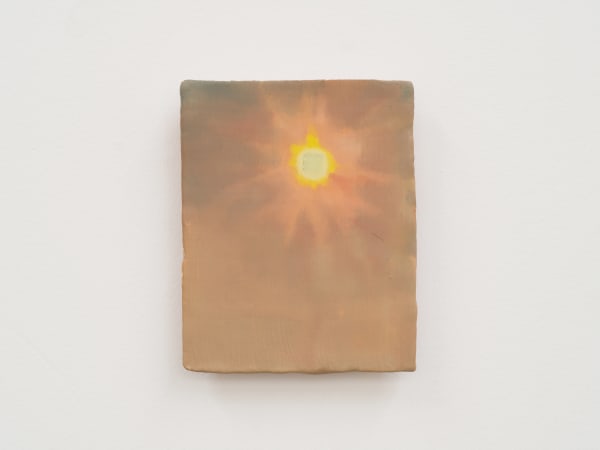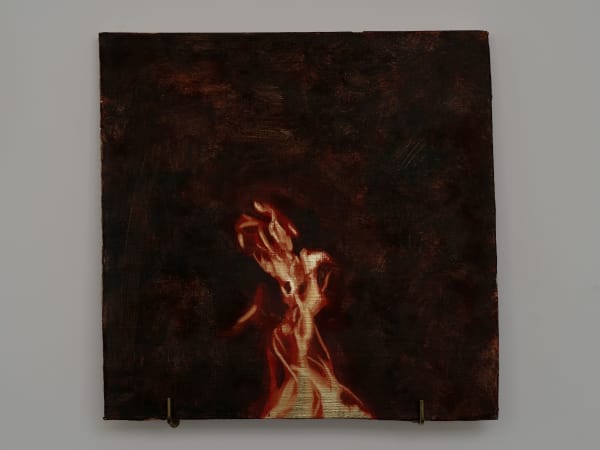-
Permeation is at the core of all painting traces. In Eastern painting, there is a saying: ‘the force penetrates the paper’s back,’ meaning that brushstrokes and ink seep through the paper, reaching its essence. In Western painting, the concept of permeation is equally fundamental. Why is an undercoat applied to canvas? Many assume the white base layer provides a pure foundation, but in reality, its original purpose was to replicate the texture of a wall—allowing ink and pigments to permeate, adhere, and gain strength through absorption.
— Xie Fan
Painting as EventMateriality and Light in the practice of Xie Fan30 March – 4 May 2025Bangkok Kunsthalle, Bangkok, ThailandXie Fan’s artistic practice is deeply engaged with the temporal and material conditions of painting. Operating at the intersection of painting, ceramics, and performance, his work resists conventional categorization, instead positioning itself as an event—something that unfolds in time, is shaped by environmental contingencies, and is ultimately ephemeral.
During his residency at Bangkok Kunsthalle leading up to the exhibition, Xie Fan will engage in material research, painting, and an in-depth exploration of local culinary traditions. The residency will culminate with the exhibition ‘Painting as Event’, taking place over three nights and merging the artist’s painting practice with performative and communal elements. Each evening, the artist will prepare and serve a meal using ceramic vessels he has crafted, situating his work within a broader discourse of materiality, ritual, and impermanence.
Central to the exhibition are dozens of small-scale terracotta paintings and a monumental sponge pigment painting that occupies both the stairwell and the second floor of the Kunsthalle. Xie Fan’s engagement with terracotta—a material historically associated with both functional craft and sacred artistic traditions—reflects his interest in the physicality of surfaces and the way they interact with light. Unlike traditional painting supports, such as canvas or wood, terracotta possesses a porous, earthen quality that influences the absorption and refraction of pigments. The artist employs a process in which mineral pigments and oxides are layered onto the raw clay surface before firing, allowing for an organic interplay between color and material. The high temperatures of the kiln cause unexpected chemical reactions, embedding a sense of chance and transformation into each work.
For Xie Fan, the act of painting is a study of permeation—how pigment enters, settles, and interacts with its support. As he describes: “Permeation is at the core of all painting traces. In Eastern painting, there is a saying: ‘the force penetrates the paper’s back,’ meaning that brushstrokes and ink seep through the paper, reaching its essence. In Western painting, the concept of permeation is equally fundamental. Why is an undercoat applied to canvas? Many assume the white base layer provides a pure foundation, but in reality, its original purpose was to replicate the texture of a wall—allowing ink and pigments to permeate, adhere, and gain strength through absorption.”This philosophy extends across his experiments with different materials, from silk to terracotta. His paintings on silk emphasize translucency and absorption, while terracotta offers a more structured, yet still porous, support. His return to painting on terracotta is not only an engagement with one of the earliest surfaces used in painting but also a meditation on the fundamental properties of pigment and ground:“I chose the red soil from Khao Yai Art Forest because early paintings relied on the simplest pigments—iron red and white—both drawn from the earth, leaving the deepest and most enduring marks. The red soil of Khao Yai is rich in iron, giving it a distinct ochre hue. I use a sponge to carry this pigment because it is the most absorbent medium, capable of retaining the most ancient colors. This fusion of natural soil with man-made materials allows permeation to become the language of the medium, bringing painting back to its most primal breath.”This material specificity extends into the way the paintings are perceived. During the day, they are illuminated by natural daylight, revealing the nuanced textures and tonal shifts embedded in the terracotta. As the sun moves across the space, so too do the paintings evolve, responding to the fluctuating conditions of light and shadow. In the evening, this experience becomes even more personal: each visitor will be given a candle, invited to navigate the exhibition space and encounter the works in an intimate, shifting dialogue between light, surface, and perception. The paintings do not simply constitute an event but are events themselves—activated by their surroundings, responsive to time and space. With each movement of the candle, the colors alter, the textures emerge and recede, and the boundaries of the image dissolve into the surrounding darkness.This attention to the encounter between pigment and support is central to Xie Fan’s broader exploration of painting as a dynamic process. His experiments with silk, for instance, further emphasize the instability of the painted image. In these works, pigments seep into the delicate fibers of the fabric, resisting containment and creating subtle, atmospheric gradations. The fluidity of silk as a support forces the pigment to behave differently than it would on terracotta or sponge, dissolving the boundaries between form and ground. In both cases, Xie Fan challenges the notion of painting as a controlled, static composition; instead, he approaches it as a negotiation between material properties, environmental forces, and the artist’s interventions.The sponge painting, by contrast, introduces a different mode of material engagement. Its porous structure, reminiscent of organic and geological formations, further dissolves the boundary between painting and sculpture. Sponge, like terracotta, is a material that absorbs and releases, retaining traces of its environment while resisting fixity. In this sense, Xie Fan’s work aligns with contemporary discourses in painting that emphasize process, material agency, and the instability of the image.By framing the exhibition as a three-night event, Xie Fan foregrounds the performative dimension of his practice. The act of serving food in his own ceramic vessels establishes a direct, corporeal relationship between the viewer and the artwork, further collapsing the distinction between art and life. The exhibition exists only for the duration of the performance, reinforcing themes of transience and impermanence. This temporality draws parallels to historical traditions of ephemeral art practices, from Buddhist sand mandalas to the performative actions of artists associated with Fluxus and relational aesthetics. However, Xie Fan’s approach remains distinctly rooted in materiality—his concern is not only with the performative gesture but also with the ways in which surfaces, substances, and sensory experiences coalesce into moments of fleeting but profound presence.“Painting as Event. Materiality and Light in the practice of Xie Fan” challenges the notion of painting as a stable, autonomous object. Instead, it invites the audience into an experience where perception is fluid, where artworks are contingent upon their environment, and where material and ritual merge to form a sensorial and communal event. Through the interplay of gastronomy, ceramics, painting, and light, Xie Fan reminds us that art is not something we merely observe but something we inhabit. It asks us to be present, to embrace the moment, and to recognize that beauty—like a meal or the glow of a candle, it is most powerful when it is fleeting.By Stefano Rabolli Pansera -
Artist Video
-
Terracotta Paintings
-
Xie Fan’s engagement with terracotta—a material historically associated with both functional craft and sacred artistic traditions—reflects his interest in the physicality of surfaces and the way they interact with light. Unlike traditional painting supports, such as canvas or wood, terracotta possesses a porous, earthen quality that influences the absorption and refraction of pigments.
-
Celestial Signs
-
Flames
-
Residency at Bangkok Kunsthalle
-
During his residency at Bangkok Kunsthalle leading up to the exhibition, Xie Fan will engage in material research, painting, and an in-depth exploration of local culinary traditions. The residency will culminate with the exhibition ‘Painting as Event’, taking place over three nights and merging the artist’s painting practice with performative and communal elements. Each evening, the artist will prepare and serve a meal using ceramic vessels he has crafted, situating his work within a broader discourse of materiality, ritual, and impermanence.
-
Painting as Event
-
By framing the exhibition as a three-night event, Xie Fan foregrounds the performative dimension of his practice. The act of serving food in his own ceramic vessels establishes a direct, corporeal relationship between the viewer and the artwork, further collapsing the distinction between art and life. The exhibition exists only for the duration of the performance, reinforcing themes of transience and impermanence. This temporality draws parallels to historical traditions of ephemeral art practices, from Buddhist sand mandalas to the performative actions of artists associated with Fluxus and relational aesthetics.However, Xie Fan’s approach remains distinctly rooted in materiality—his concern is not only with the performative gesture but also with the ways in which surfaces, substances, and sensory experiences coalesce into moments of fleeting but profound presence.“Painting as Event. Materiality and Light in the practice of Xie Fan” challenges the notion of painting as a stable, autonomous object. Instead, it invites the audience into an experience where perception is fluid, where artworks are contingent upon their environment, and where material and ritual merge to form a sensorial and communal event.
-
 Portrait of Xie Fan in his studio. Photo: Song Wenting
Portrait of Xie Fan in his studio. Photo: Song Wenting -
Subscribe Newsletter
Be the first to know about new exhibitions, artist updates, as well as books and more. Sign up for our newsletter below.



























